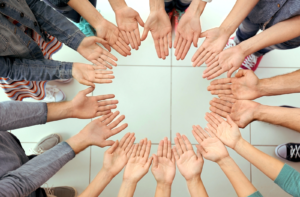
La ciudad de Los Ángeles ha lanzado a nivel nacional la iniciativa “Nuestro Futuro compartido”, es una serie de programas públicos que buscan acercar a la comunidad, a través de un viaje que les permita conocer su pasado racial en Museos y espacios libres, dando voz a los que cuentan sus historias de vida.
Esta iniciativa comenzó en el 2020 a raíz del asesinato de George Floyd; fue así que se buscó participar y colaborar con otras instituciones, el Instituto Smithsonian trabajó en todas sus alcances para abordar los problemas, pero no solo del racismo, sino buscando un mejor futuro para todos, señaló Deborah L. Mack, directora del Smithsonian de Nuestro futuro compartido, durante una sesión informativa realizada por Ethnic Media Services.
Así, junto con instituciones culturales y museos de todo el país, presentan una serie de programas públicos entre el 1 y el 17 de diciembre para explorar cómo la raza ha transformado cada una de nuestras vidas, y cómo los acontecimientos racistas y las políticas del pasado se conectan con las desigualdades evidentes en nuestra sociedad en la actualidad.
“Smithsonian, no es una agencia de servicios sociales, pero si trabajan con socios en todo el país como instituciones culturales, se enfoca en áreas distintas como la raza y bienestar, cosas estéticas y de cultura, ya que los Estados Unidos es un país altamente globalizado”, explicó Deborah L. Mack.
Para Mack, es importante confrontarnos con nuestra historia para poder entender cómo llegamos a lo que es hoy en día, y poder utilizar lo que hemos aprendido y tener un mejor futuro, de esta manera podemos crear y transformar a la sociedad para mantenerla más unida y comprensiva.
Leticia Rhi Buckley, directora general de la Plaza de Cultura y Artes, piensa que es muy importante que las historias sean contadas por ellos mismos, por lo que han vivido los hechos “los llevamos al pasado para entender cómo están pasando las cosas y porque pasaron de esa manera”, comentó.
“Debemos entender el pasado, pero no es lo que sucedió hace años, o hace un año, el pasado es algo que podemos ver hace un mes, una semana, de esto debemos hablar, de los retos a los que nos enfrentamos ahora y trabajar juntos en comunidad”, agregó.
Para Leticia Rhi unir a las comunidades a través de las experiencias es algo que puede cambiar el futuro y dar mejores oportunidades a todos, sin embargo es necesario entender el pasado como algo que se vive hoy mismo, no dejar a un lado los acontecimientos que lastiman a las comunidades e ignorar el daño que han hecho.
“Durante el último año trabajamos con la organización regional de Oaxaca en programación multidisciplinaria e intergeneracional donde se busca trabajar con aliados que también quieren llegar a este fin, colaborando para construir nuevos sistemas y lograr los cambios que se necesitan”, agregó Leticia Rhi Buckley.
La directora general de la Plaza de Cultura y Artes, explicó que son pocas las personas que hacen estas iniciativas y por lo mismo se vuelven necesarias para la comunidad, algo que les permite seguir adelante como motivación para lograr los cambios que esperan.
James Herr, director del Centro Nacional para la Preservación de la Democracia del Museo Nacional Japonés Americano, celebra 20 años de espacio, un lugar que enaltece la experiencia chino- americana donde las historias que se están contando son parte de la historia de Estados Unidos, buscando reconciliarse con el pasado.
“Cuando abrimos, sabíamos que necesitábamos un espacio para compartir nuestras historias, estamos reclamando una historia olvidada desde el pasado para no tener que volver a vivir lo mismo”, comentó James Herr.
Para poder enfrentar el pasado racial es necesario conocer los hechos, sino se tiene ese conocimiento no se sabe a que se enfrenta, de esta manera no se puede pensar en sana si ni siquiera se tiene una idea de lo que se quiere sanar, para eso está este proyecto, un ejemplo de esto es la masacre china de 1871, explicó el experto.
“La masacre china de 1871 sucedió en Los Ángeles, donde hubo 2 personas que se estaban peleando y durante esta pelea se dispararon y una persona fue asesinada, después fueron a Chinatown donde asesinaron a 18 niños y adultos hombres, ahora historias como estas fueron olvidadas”, subrayó Herr.
Destacó que este museo da la oportunidad de contar las historias desde la comunidad lastimada para que sea lo más exacto posible al hecho, de esta manera se busca tener un lugar donde las personas se unan, ya que la división ha hecho que incremente la violencia y los actos de odio.
“Tenemos que entender nuestra historia cuando la retórica es dañina, ya que puede terminar en violencia, entonces cuando se escucha esta retórica que lastima, debemos de frenar esos discursos para que no continúe y eso es lo que estamos haciendo ahora”, concluyó James Herr.
Michael Truong, director ejecutivo de Chinese American Museum, explicó que este lugar es muy especial para la comunidad, donde se busca tener conversaciones alrededor de la raza ya que la comunidades americanas están siendo marginadas en Estados Unidos.
“Tenemos una exhibición que viene de Smithsonian que se llama El sesgo interior o el prejuicio interior, y eso ve el tema de un prejuicio implícito y dañino. Es importante ver el prejuicio desde un punto científico ya que todos tenemos prejuicios de manera natural”, comentó Michael Truong.
Para Truong, estos proyectos tienen gran valor en las comunidades, se espera que todas estas experiencias, proyectos y más ayuden a unir a la gente, a entender lo que sucede para construir empatía con todas las comunidades en el país.
“Los museos son espacios donde se cuentan historias, se cuenta nuestra verdad pero también es un espacio donde se espera aprender, creamos estatuas para conmemorar y recordar cosas que son importantes, cosas que no debemos olvidar”, concluyó Michael Truong.
Te puede interesar: Autoridades federales rompen barreras lingüísticas para cuidar a la comunidad de fraudes

